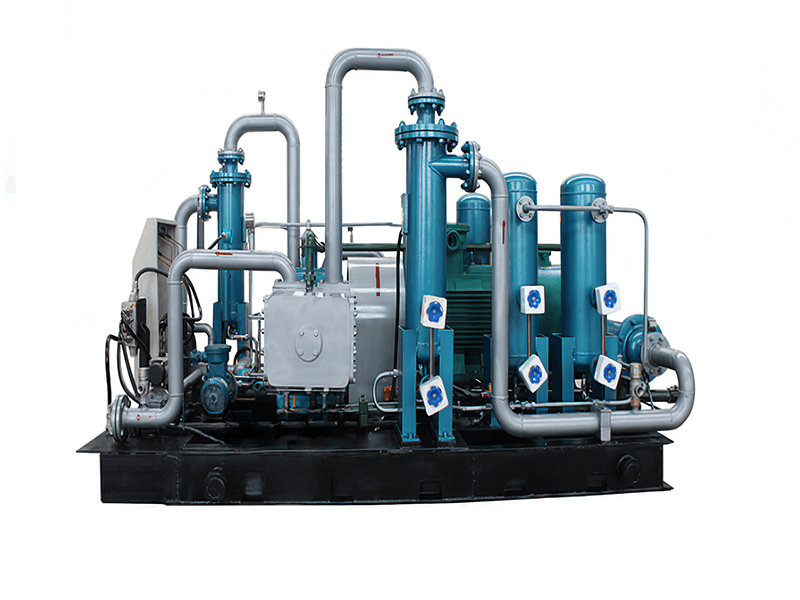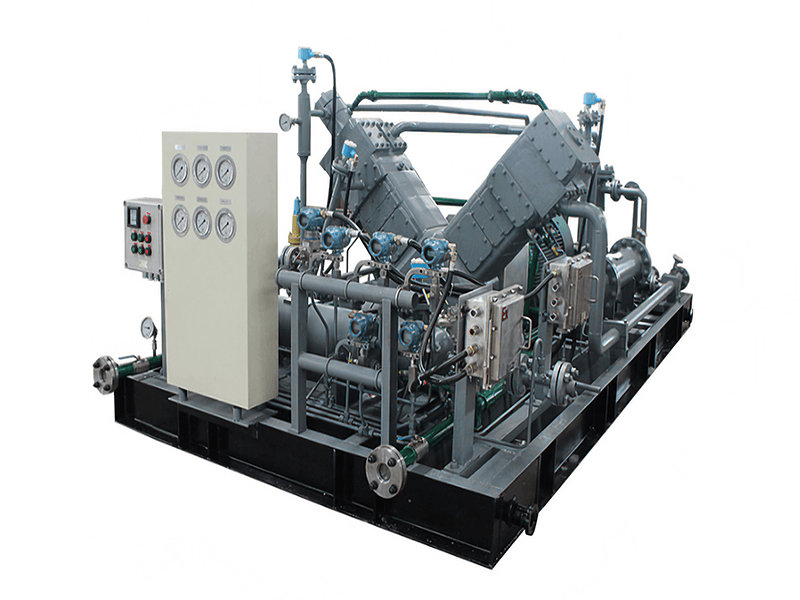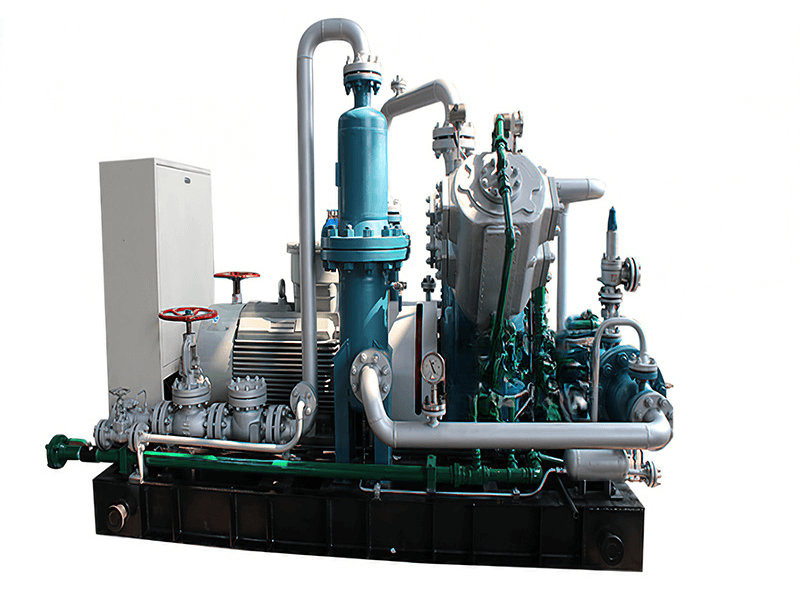As an important by-product in the process of oil extraction, Associated Gas is not only an energy resource, but also a key target for environmental protection. This kind of gas usually contains methane, ethane and other hydrocarbon components, accompanied by hydrogen sulfide, carbon dioxide and other acidic gases and solid impurities, its recovery and treatment of energy efficiency and environmental protection is of great significance. With its unique technical advantages, piston compressor shows irreplaceable value in the field of petroleum associated gas treatment. This article will comprehensively analyze the application of piston compressors in the field of petroleum associated gas from the aspects of industry pain points, technical advantages, typical cases and development trends.
1.Industry Pain Points of Petroleum Associated Gas Treatment
Petroleum associated gas is characterized by complex components, high pressure fluctuations and impurities. Traditional treatment methods often face the following challenges:
A.Gas corrosiveness is high:
Petroleum associated gas generally contains hydrogen sulfide (H₂S) and carbon dioxide (CO₂) and other acidic gases. H₂S dissolves in water to form weak sulfuric acid, which causes serious corrosion of metal equipment. For example, an oil field once failed to use anti-corrosion measures, resulting in perforation of compressor valve plates after 2,000 hours of operation and a 40% increase in maintenance costs. In addition, CO₂ in the high-pressure environment is easy to combine with water to form carbonic acid, further aggravating the corrosion of equipment.
B.Operating conditions fluctuate dramatically:
Wellhead pressure usually shows significant fluctuations with the extraction cycle. In an onshore oil field, for example, the initial extraction pressure can reach 4MPa, and then drop to below 0.5MPa in the middle and late stages. The efficiency of conventional centrifugal compressors drops by 30% at pressures below 1.5MPa, while screw compressors have difficulty adapting to high pressures above 4MPa. This volatility leads to frequent starts and stops of the equipment, increasing energy consumption and shortening the service life.
C.Impurities are difficult to handle:
Associated gas often contains sediment with a particle size of 5-50μm, oil mist (concentration 100-500mg/m³) and free water. An offshore platform once caused carbon buildup on the impeller of a centrifugal compressor due to oil mist condensation, and the cleaning cost alone amounted to 1.2 million RMB/time. In addition, solid particles will accelerate cylinder wear, and the maintenance cycle of ordinary compressors under such conditions is usually less than 500 hours.
2.Technical advantages of piston compressors
Compared with centrifugal and screw compressors, piston compressors have significant competitiveness in associated gas treatment:
A.Material corrosion resistance breakthrough
1) Duplex Stainless Steel Cylinder Body: Made of UNS S31803, its H₂S corrosion resistance is 5 times higher than that of 304 stainless steel.
2) Surface Strengthening Technology: 50μm tungsten carbide coating is formed on the inner wall of the cylinder block by high-speed flame spraying (HVOF), which reduces the corrosion rate to 0.002mm/year.
3) Polymer sealing components: polytetrafluoroethylene (PTFE) and polyether ether ketone (PEEK) combination sealing, with a service life of 8,000 hours under sulfur-containing working conditions.
B.Wide range of pressure adaptability
Through multi-stage compression design (usually 3-5 stages), the gas with inlet pressure as low as 0.1MPa can be gradually pressurized to 25MPa. The compression ratio of each stage is strictly controlled between 2.5-3.5 to avoid the gas temperature exceeding 150℃ (high temperature accelerates the aging of materials). Measured data from a project show that the piston compressor can still maintain an isentropic efficiency of more than 85% within the pressure fluctuation range of 0.3-6MPa.
C.Intelligent conditioning
Equipped with a stepless air volume adjustment system, continuously adjustable from 0-100% load by hydraulic drive. When detecting a drop in gas volume, the system can shut down part of the cylinder within 3 seconds, so that the power consumption and gas volume are linearly decreasing. An oilfield application case shows that the system can reduce energy consumption under part-load conditions by up to 35%.

3.Global typical project in-depth analysis
Case 1: China Bohai Offshore Platform High Pressure Reinjection Project
Project background: need to treat associated gas containing H₂S 2.8%, CO₂ 6.2%, daily processing capacity of 200,000m³, target pressure 8MPa.
Technical program:
ØSelection of three DW-42/8 type piston compressor, single power 1600kW
ØThree-stage compression (0.15 → 1.2 → 4.0 → 8.0MPa), the interstage configuration of shell and tube cooler;
ØValve group adopts titanium alloy valve plate + graphite sealing ring.
Operational effectiveness:
Ø12,000 hours of continuous operation without overhaul under sulfur conditions;
ØUnit energy consumption reduced by 18% compared with the original centrifugal unit;
ØAnnual recovery of liquefied petroleum gas (LPG) reaches 12,000 tons, generating an efficiency of 36 millionRMB.
Case 2: Middle East desert oil field associated gas liquefaction project
Extreme challenges: ambient temperature 55℃, gas containing H₂S 15%, dust 300mg/m³.
Innovative design:
ØCompressor room adopts closed loop cooling system to ensure the inlet gas temperature<40℃;
ØCylinder hard chrome plating treatment (thickness 0.1mm), wear resistance increased by 3 times.
ØConfiguration of vibration online monitoring system, warning accuracy rate of 98%
Economic Indicators:
ØLNG production increased to 280,000 tons/year, increasing revenue by US$120 million;
ØEquipment payback period of only 2.3 years.
Case 3: Distributed processing in North American shale gas field
Scenario characteristics: 15 decentralized wellheads, single well production 5000-30000m³/day
Modularized solution:
ØDeploy 25 containerized piston units with a single processing capacity of 5000m³/h;
ØEach unit integrates IoT terminals to realize centralized monitoring in the cloud.
Environmental benefits:
ØMethane fugitive rate reduced from 7.2% to 0.5%, annual emission reduction of 500,000 tons of CO₂ equivalent;
ØObtained carbon trading revenue of 2.8 million USD/year.
4.Technology Development Trends and Market Prospects
A.High pressure and large-scale
ØThe research and development of new ceramic composite material cylinder, so thatthe working pressure exceeds 30MPa;
ØStand-alone power to 5000kW level development, processing capacity of 600,000m³ / day.
B.Intelligent Upgrade
ØDigital twin system maps equipment status in real time through 2000+ sensors, with failure prediction accuracy of over 90%;
ØAI algorithm optimizes the compression ratio allocation, which is expected to increase energy efficiency by another 5-8%.
C.Decarbonization Integration
ØWaste heat recovery unit converts 40% of compression heat into electricity, reducing overall energy consumption by 15%;
ØCarbon capture module integrated directly into the compression process, reducing CO₂ capture costs to $30/tonne.
D.Market forecast
According to Global Market Insights, the oil associated gas treatment equipment market size will grow at a CAGR of 9.5% from 2023-2030, with piston compressor market share expected to increase from 35% to 48%. Driven by carbon tariffs and other policies, the demand for equipment replacement will explode.
5.Conclusion
Through material innovation, structure optimization and intelligent control, the piston compressor has successfully overcome the three major technical barriers of corrosion, fluctuation and impurity in the treatment of associated petroleum gas. Practices from Bohai Sea to the Middle East have shown that this technology can not only realize an annualized ROI of more than 18%, but also be the core equipment for oil companies to achieve the goal of “Zero Combustion and Removal”. With the maturity of 30MPa ultra-high-pressure unit and digital twin technology, piston compressor will continue to play a key role in energy transformation, and promote the oil and gas industry to the direction of high efficiency and low carbon.

























